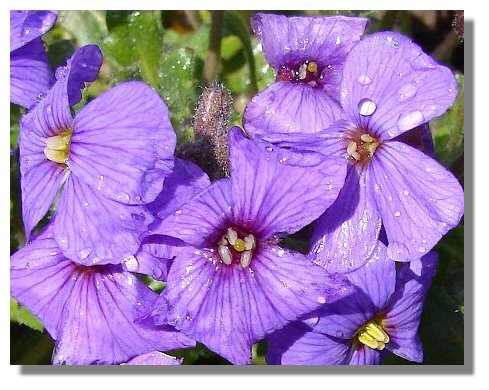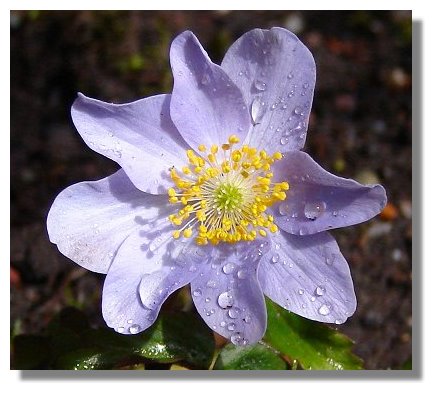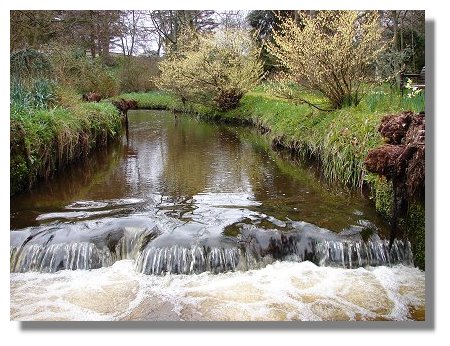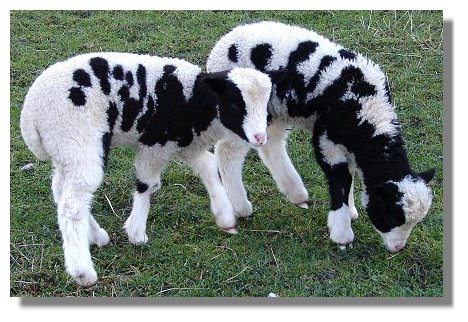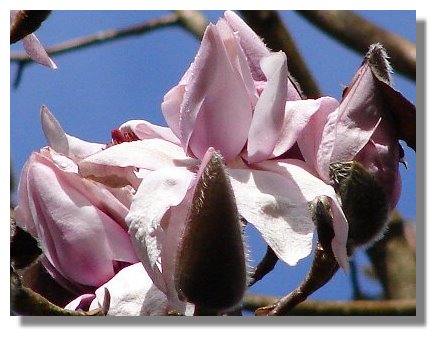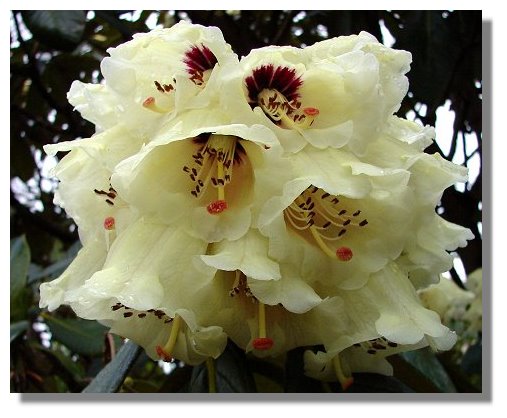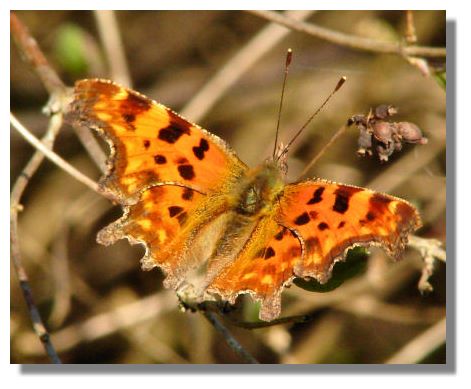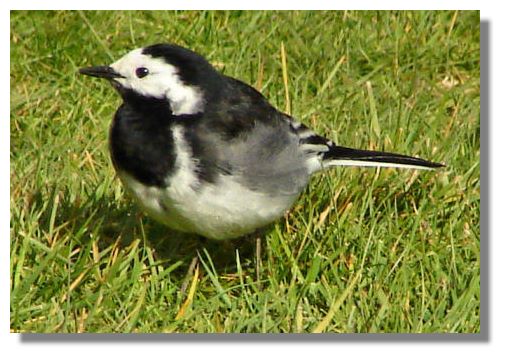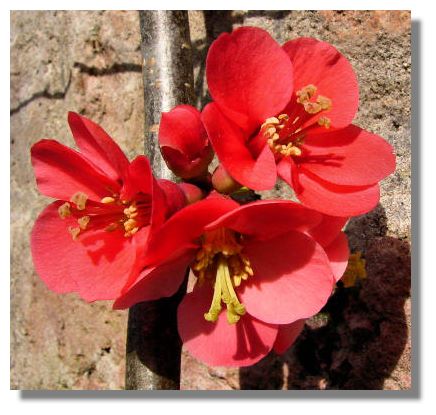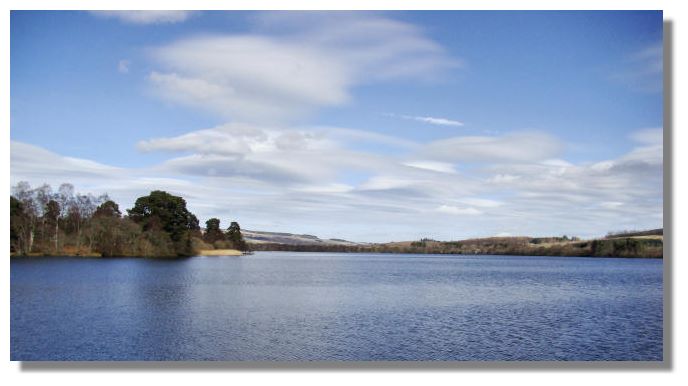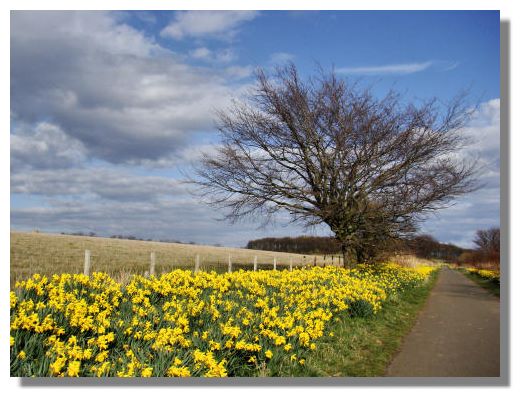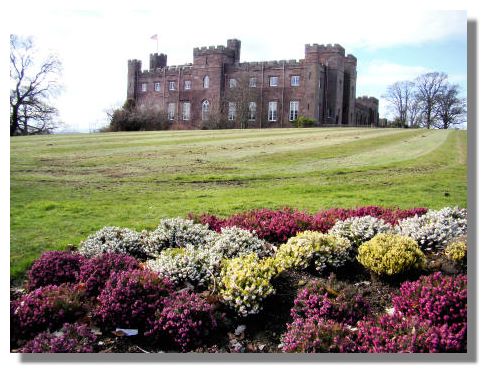The first two pictures in this section illustrate very well some of the weather in Scotland this week - heavy showers and sunshine. What this graphic of Aubretia covered in water droplets cannot convey is the strong wind and the low temperatures for this time of year.
Anemones of different types flower in various seasons of the year. This small, delicate Anemone Nemerosa, seen here at the National Trust for Scotland Geilston Garden near Cardross in Argyll, is the spring-flowering variety.
Although the National Trust for Scotland Geilston Garden is technically in Argyll, it is not far from Dumbarton, overlooking the Firth of Clyde. The delicate yellow flowers on the shrub beside the stream are Corylopsis. For more on Geilston, see Places to Visit - Geilston.
These young goats were born at Ardardan Farm between Cardross and Helensburgh only recently. The working farm has a shop selling fresh produce and a popular tearoom with home baking. It's not often that you can see the free range chickens that supplied the eggs that you buy in the shop or which go into the cakes you eat with your afternoon tea!
A few days before this picture of a Magnolia bursting into blossom was taken, there had been a sharp frost which scorched many of the other blooms on this tall tree at Glenarn House in Rhu, turning them brown. Many of the Camellias in the garden had also been damaged by the frost.
Although the Magnolias and Cammelias had been affected by the low temperatures, there were many other flowers which had coped very well - such as this magnificent Rhododendron.
The Comma butterfly declined dramatically in Britain in the 19th century and by 1920 there were only two sightings in the UK. It has since staged a dramatic come-back, mainly in the south of England. But a few have been seen in Scotland, though the numbers reported to the Butterfly Conservation Scotland in recent years have been in single figures. I was fortunate to see one three years ago (a rather ragged specimen) so I was delighted to see this perfect specimen. It will have hibernated over the winter and the recent warmer weather will have enticed it out.
The Pied Wagtail's jerky walk and bobbing tail make it a popular bird in open parkland or beside rivers and streams - it can catch insects in mid-air. It is a shy bird, so getting close for a photograph is a rare event!
Chaenomeles - flowering quince - produce clusters of blossom on bare branches. Each flower is about 2" across. The shrub is often trained against a wall, as here.
Loch of Lowes in Perthshire near Dunkeld has become a popular wildlife reserve mainly because of the ospreys that nest there every year. The newly upgraded visitor centre displays videocam pictures taken from close to the nest and from April to August there are great views of the chicks being fed by both their parents. Ospreys catch fish from the loch, diving down to pluck their prey from the water. The nest at Loch of Lowes is clearly visible across the loch from a hide set up by the Scottish Wildlife Trust. Although I got some pictures of the two nesting birds (recently returned from West Africa), the distance involved meant that the pictures were not good enough for this colour supplement.
The Fife Coastal Path between Delgaty Bay and Aberdour at this time of year is an amazing sight with golden daffodils on either side stretching into the distance. The daffodils were planted by volunteers in support of the Marie Curie Cancer Care charity. Some of the daffodils are picked and sold in local shops to raise funds for the charity - but plenty are left to make this a beautiful walkway.
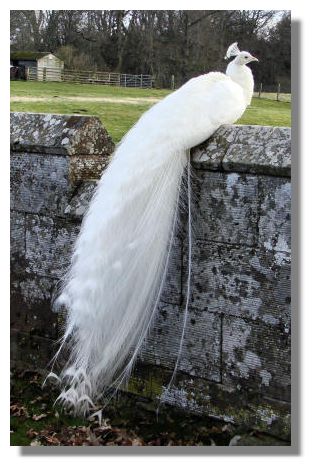
We usually see the magnificently coloured Peacocks with their extravagant tails and iridescent blue-green or green coloured plumage. Equally striking is the white Peacock. This is not an albino - just a variety that has been bred to produce pure white feathers. This is one of a number which strut around the grounds of Scone Palace in Perthshire.
Kenneth mac Alpin moved his centre of power to Scone (pronounced Scoon) and Dunkeld in the 9th century as his western province of Dalriada (Argyll) came under increasing pressure from the Vikings. The Stone of Destiny, on which generations of kings had been enthroned, was also moved to Scone - these days, only a replica stands in the grounds. An Augustinian Abbey was built by Alexander I in the 12th century. The Abbey was destroyed during the Reformation in the 16th century. Parts of a 17th century house, which was built on the site of the Abbey, were incorporated into Scone Palace when it was built in 1802 by the 3rd Earl Mansfield. From the outside, it is not all that impressive to look at - the castellations were added in a 19th century "makeover" to make it look more like a castle.If you want to look back at other editions of these photos of Scotland week by week, there is an Index Page
